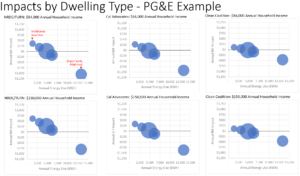
2024 Q1 Legislative Roundup
In this Legislative Roundup written by the Clean Coalition, we lay out the key DER energy-related bills currently making their way through the California legislature this year.
2024 Q1 Legislative Roundup
California has set ambitious clean energy goals, aiming to achieve carbon neutrality and rely on 100% clean energy by 2045. The wide scale proliferation of distributed energy resources (DER) such as local solar and storage is crucial for meeting these goals and setting the stage for community-scale resilience. Locally produced renewable energy reduces the need for expensive transmission infrastructure to transmit remote renewables to end-users and prepares the local distribution grid for DER-powered Community Microgrids, capable of providing resilience to entire regions in the face of increasingly frequent and severe natural disasters and extreme weather patterns.
However, lack of effective policies and market mechanisms stands in the way of wide scale DER proliferation. Local solar, in particular, has been threatened by policy and regulatory changes that have depressed its value and drastically reduced installation rates in recent years. With the clock ticking on our clean energy goals, passing effective legislation to promote a DER-driven future is more important than ever.
Below are key DER energy-related bills currently making their way through the California legislature this year.
- Senate Bill 1148 (Blakespear and Wahab)
- Assembly Bill 3111 (Calderon)
- Assembly Bill 2619 (Connolly)
- Assembly Bill 1999 (Irwin)
- Senate Bill 1374 (Becker)
- Senate Bill 938 (Min)
- Other bills to look out for:
Support Senate Bill 1148 (Blakespear and Wahab): Resilience for Multi-Unit Housing, Government Facilities (including schools), and Places of Worship
- Bill status: Referred to Senate Committee on Energy, Utilities and Communications and Labor, Public Employment and Retirement Committee on 21 February 2024. Set for a hearing on April 16 and April 24 2024.
SB 1148 enables resilience at multi-unit housing, local government facilities (including schools), and places of worship in a streamlined and efficient manner by allowing the use of a master meter. A master meter serves as the point of connection between the site and the distribution grid, allowing the deployment of renewable resources behind-the-meter (BTM) to provide resilience. At multi-family housing sites, unit-level private sub-meters will allow residents to be conscientious of their individual usage and enable compensation from participation in energy programs—such as the Net Billing Tariff—to be distributed in a fair and equitable manner. Private sub-meters also preserve incentives for energy efficiency and conservation, guarantee accurate billing, and prevent consumer protection violations.
NEM & VNEM Configuration Differences During A Grid Outage (resilience)

When implemented, SB 1148 will remedy the fact that there is currently no standard or streamlined pathway across the IOU service territories that allows multi-unit residential housing sites, government facilities (including schools), and places of worship to provision resilience. SB 1148 will also protect consumer interests by requiring utility bill savings for residents (e.g. a lower cost of energy than the normal utility bill post-deployment of the master meter) and by encouraging the development of energy-efficient electrified multi-unit housing projects.
Oppose Assembly Bill 3111 (Calderon): Requiring DER Deployers to Register as Electrical Corporations
- Bill Status: Referred to Assembly Committee on Utilities and Energy and Natural Resources on 11 March 2024
AB 3111 requires the owner of a customer-sited solar system above 80 kW or energy storage sized above 100 kWh to provide information for a public database and register with the Commission as an electrical corporation. The bill also has the same requirements for an aggregator with resources that have a generating capacity of 80 kW or a storage capacity of above 100 kWh.
Registering as an electrical corporation comes with strict regulatory and reporting requirements that can be extremely costly to comply with. If passed, AB 3111 will significantly limit the number of DER deployments in the future, make achieving California’s climate energy goals far more challenging, and eliminate the possibility of community-scale resilience.
Support Assembly Bill 2619 (Connolly): Reforming Net Energy Metering
- Bill status: Referred to Assembly Committee on Utilities and Energy on 4 March 2024
AB 2619 reinstates incentives for local solar and other clean energy resources by mandating the California Public Utilities Commission (CPUC) to revise its Net Energy Metering (NEM) program and prohibits any new charges, taxes or fees on Community Solar. NEM permits a customer to receive credits for on-site solar generation exported to the grid. The most recent NEM program, called the Net Billing Tariff or NEM 3.0, was implemented in 2022 and significantly reduced the credit utility companies are required to pay to residents with local solar. Overnight, compensation was cut by over 70%. This has severely diminished the value of local solar, and demand for new rooftop solar installations has correspondingly plummeted. According to an analysis from Wood Mackenzie, the market for residential solar will be cut at least in half by this year as a result of NEM 3.0 forcing solar companies out of business. Additionally, the average payback period for a residential solar customer will increase from 5-6 years to 14-15 years. This renders deploying local solar simply infeasible for most Californians.
To reach California’s clean energy goals, local solar must be deployed at record-breaking rates. The CPUC’s NEM 3.0 decision works directly against these goals and casts uncertainty over a clean energy future. AB 2619 is crucial for aligning NEM with the state’s clean energy goals while prohibiting future solar taxes that stand in the way of widespread deployment of local, clean energy resources.
Support Assembly Bill 1999 (Irwin): Repealing the AB 205 Fixed Charge
- Bill status: Referred to Committee on Utilities and Energy on 12 February 2024
The passage of AB 205 in 2022, which requires the CPUC to authorize an income-based Fixed Charge, threatens to disincentivize energy-saving technologies, resulting in higher rates for low and medium-income customers who use energy most efficiently. AB 1999 protects California ratepayers from a high Fixed Charge by capping it at $5/month for CARE customers and $10/month for all other California ratepayers, establishing a modest Fixed Charge in line with the Clean Coalition’s Fixed Charge Proposal.
A high Fixed Charge, as proposed by the Investor-Owned Utilities (IOUs), is not a long-term affordability solution It fails to address the underlying cost drivers (e.g. transmission spending) that lead to rate increases. It only reduces volumetric rates just enough to mask the severity of the affordability crisis, downplaying the need to both substantially reform rates and curb overspending on transmission infrastructure. Furthermore, a high Fixed Charge yields immediate cost increases for most low-and medium-usage households, regardless of changes in energy consumption patterns. Single-family, high-income households would experience the greatest savings from a high Fixed Charge, while multi-family dwellings with low electricity usage, composed mainly of renters who correlate to low income, would experience the greatest monthly bill increases.

In addition to being inequitable, a high Fixed Charge reduces price signals that incentivize energy conservation during periods of peak demand. When a significant portion of one’s energy bill is an unavoidable Fixed Charge, the volumetric savings from conserving energy and using the grid intelligently are greatly diminished. Similarly, the value of rooftop solar and other DER technologies is depressed by a high Fixed Charge. This moves California further away from the grid of the future and stands in stark contrast to the state’s clean energy goals.
The passage of AB 1999 bans the use of a high Fixed Charge that punishes rooftop solar and energy efficiency technologies, thereby reducing distortions in market incentives for energy conservation. This is crucial for preserving market mechanisms that promote energy conservation and DER deployment.
Support Senate Bill 1374 (Becker): Allowing on-site netting for VNEM & NEMA tariffs
- Bill status: Referred to Committee on Energy, Utilities, and Communications on 2 April 2024
SB 1374 ensures that schools, renters, and farms receive proper compensation for energy produced by on-site renewables under the NEM Aggregation (NEMA) program.
In late 2023, the CPUC made a change to its NEMA tariff that had previously facilitated the deployment of local solar at many multi-meter facilities by ending the practice of on-site netting. This change banned multi-meter customers, such as schools, from aggregating solar energy generated on one meter for use on another meter. Instead, excess energy is compensated minimally as an export to the grid while metered usage is billed at the full retail rate, even when both meters are located on the same property.
Onsite solar is deployed at a facility so the facility can both generate and consume or store energy in real-time without using the broader distribution grid or the transmission system, thereby reducing energy costs and increasing energy independence. When on-site netting was removed in the new NEMA tariff, the energy cost savings of local solar and storage were reduced by roughly 75%. Consequently, local solar and storage deployment for multi-meter facilities has been dramatically reduced. It is simply not economically feasible to deploy these energy technologies when their benefits are undervalued.
As in single-meter facilities, energy deployed on-site is used on-site, regardless of whether it is located in front of or behind the customer’s meter. SB 1374 acknowledges this fact and ensures that customers with multiple meters receive the full financial benefits of on-site energy generation and consumption. This bill will reinstate the financial incentive for schools, universities, farms, and apartment buildings to deploy local solar, setting the stage for widespread energy resilience across multimeter facilities.
Support Senate Bill 938 (Min): Preventing ratepayer funds from being spent on utility lobbying
- Bill status: Referred to Committee on Energy, Utilities and Communications on 14 February 2024
In 2023, SoCalGas spent at least $36 million in ratepayer funds for political lobbying to oppose California’s Clean Energy goals. This instance is just one of many examples of misuse of ratepayer funds aimed at fighting California’s electrification goals. The IOUs continue to request double-digit rate increases while spending ratepayer dollars on lobbyists, private lawyers, and marketing to influence politicians and regulators.
SB 938 will prevent utilities from using ratepayer dollars for political influence activities or advertising. The CPUC will require the IOUs to release publicly available reports about where their money spent on lobbying comes from, with a civil penalty for disobedience. The majority of the money collected from this penalty will be used to assist electrification of low-income housing. As monthly utility bills continue to rise, establishing firm guidelines with transparent reporting for how this money is spent is crucial for ensuring that Californians are not footing the bill for political lobbying aimed at fighting against our climate and clean air goals.
Other bills to look out for and support:
- AB 2054 (Bauer-Kahan): Closes the revolving door by establishing a 10 year “cooling off” period for former CPUC commissioners before they can be employed by the companies they regulate, removing undue industry influence on these regulatory agencies.
- AB 2256 (Friedman): Finding the “true” value of local solar. Requires the CPUC to include all the benefits of rooftop solar (e.g. better local air and water quality, avoided land use impacts) when deciding how much credit solar users receive.
- AB 3118 (Wallis): Establishes rooftop solar as the “official state energy” of California.
- SB 233 (Skinner): Bidirectional EV charging. The bill will help create a cleaner, safer, and more resilient and reliable system for California, reducing the use of fossil fuel generators.
As the state moves towards its clean energy goals, it is crucial to ensure that policies are in place to support the widespread deployment of these technologies. We highlight two bills that are currently being considered by the state legislature, AB 1999 and SB 1374, which would help to promote local solar and energy efficiency. We also provide information about how to support these bills and get involved in the fight for clean energy in California.

